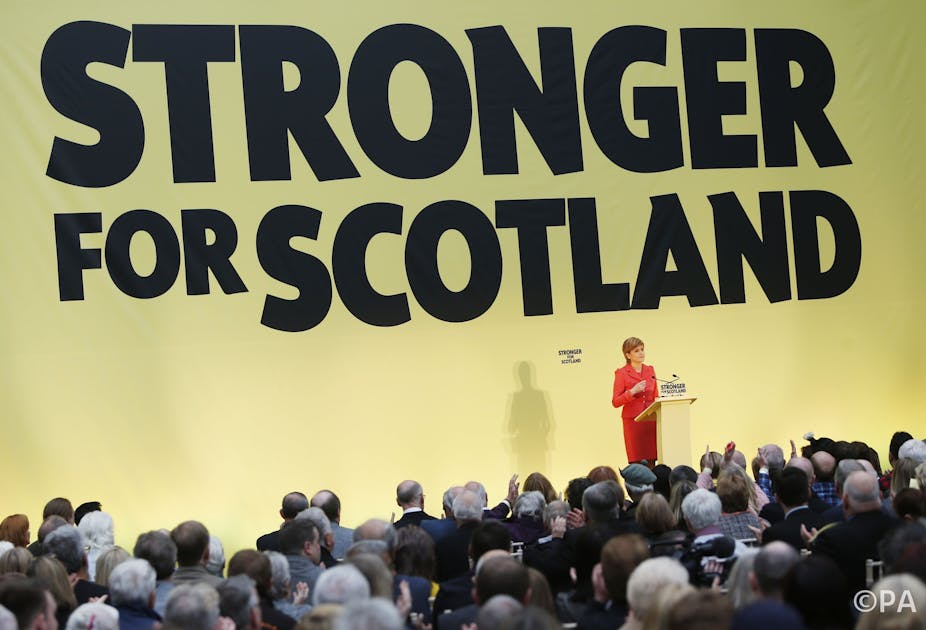The publication of the SNP’s 2015 general election manifesto marked a huge change for the party. This manifesto – unlike its predecessors – sets its sights beyond the Scottish border. It seeks to promote “positive change for the benefit of ordinary people, not just in Scotland, but across the UK”. It makes the case for more “progressive politics”, and positions the SNP to the left of the Labour Party.
Specifically, the manifesto argues for an end to austerity: the SNP proposal is for a 0.5% annual increase in public spending over the course of the next parliament, rather than the reductions in spending which George Osborne laid out in his March 2015 budget.
Ending austerity
The SNP claims that increased spending would still lead to a reduction in the deficit as a share of GDP, based on a Treasury costing of the policy, which was proposed by the Scottish government in March 2015. Under the SNP strategy, the deficit would be 2% of GDP by 2019-20. This stands in contrast to the latest UK government forecast, which predicts of a surplus of 0.3% of GDP by the same time based on the current approach.
Some economists, among them Simon Wren Lewis, Jonathan Portes and Paul Krugman, argue that the coalition government’s focus on deficit reduction is unhealthy in the long term for the UK economy. So the SNP can reasonably claim that its proposal to end austerity has significant intellectual support.
On the other hand, the SNP case is based on forecasts made by the Office of Budget Responsibility (OBR), whose record has been, at best, mixed. The International Monetary Fund suggests that the OBR’s deficit forecast for the end of the next parliament is too optimistic. And the UK is in the middle of a retirement boom, which will undoubtedly add to the pressures on public finances.
In light of these circumstances, there is now a spectrum of proposals for how quickly different parties will deal with the deficit. The Conservatives are at one extreme, favouring a rapid reduction in the deficit, while the SNP are at the other, suggesting a very muted response.
Scotland’s deficit problem
But the SNP has another economic issue on its plate: Scotland’s deficit. The Scottish government estimated that there was a difference of £12.4 billion (or 8.1% of GDP) between the amount of taxes raised and public spending in Scotland in 2013/14. In comparison, the deficit for the UK as a whole was £97.3 billion (or 5.6% of GDP) in the same period.
During the recession, Scotland’s deficit broadly tracked that of the UK as a whole. The increase in 2013/14 was principally caused by the collapse in the price of oil and the consequent downturn in North Sea oil revenues. The economic case for independence, published before the referendum, relied heavily on North Sea oil revenues. The Scottish Government estimated that these would be £7.3 billion in 2015/16: the latest OBR forecast is that North Sea corporation tax and petroleum revenue tax will only raise £0.7 billion in 2015/16.
Until recently, the SNP was arguing for “full fiscal autonomy”, which would mean the Scottish Government becoming responsible for all taxes and public spending in Scotland. It would also involve making a payment to the UK government for those public services shared with the rest of the UK such as defence, foreign affairs, development aid and debt interest.
But with such a large deficit to deal with, full fiscal autonomy (and indeed independence) becomes much less attractive. The IFS estimates that the Scottish Government would have to find £7.6 billion to continue funding its public services at their current rate, while reducing the Scottish deficit to the same level as the rest of the UK. Over time, while Scotland’s deficit would fall as a share of GDP, the IFS prediction is that the difference between the Scottish and UK deficits will continue to grow.
A change in rhetoric
It is therefore not surprising that full fiscal autonomy is no longer a “red line” issue for the SNP, which must be delivered quickly. Instead, the phrase has been replaced by the somewhat more opaque “full fiscal responsibility”, which appears to be a more long-term objective. And for the short-term, the manifesto supports using the Barnett Formula as the main mechanism for determining Scotland’s finances. This is not surprising, given claims that this mechanism has provided Scotland with a relatively generous share of UK public finances since it was introduced in the 1970s.
And although SNP support for the Smith Commission proposals on increased tax powers for Scotland was lukewarm at best, the manifesto is clear: “We will demand that the proposals of the Smith Commission are delivered quickly and in full.” If enacted, the proposals will leave Scotland with an extremely complex set of fiscal arrangements, incorporating new taxes, welfare powers and an adjusted Barnett Formula.
But there is a chance that the legislation itself could destabilise the next administration. In the present climate, a continuation of Barnett while giving Scotland new tax powers is likely to encounter significant opposition outside Scotland, some of which may cut across party lines.
The Conversation’s Manifesto Check deploys academic expertise to scrutinise the parties’ plans.

